Investing in cryptocurrency can feel like riding a rollercoaster. Prices swing wildly, sometimes changing by 30% in a single day. This volatility makes it difficult to know when to buy, especially if you’re new to crypto investing. That’s where dollar-cost averaging (DCA) comes in – a simple yet powerful strategy that can help you navigate the unpredictable crypto markets with confidence.
This beginner-friendly guide will walk you through everything you need to know about implementing a DCA strategy for your cryptocurrency investments, helping you build a solid portfolio while minimizing the stress of market timing.
What is Dollar-Cost Averaging in Cryptocurrency?
Dollar-cost averaging (DCA) is an investment strategy where you invest a fixed amount of money in cryptocurrency at regular intervals, regardless of the asset’s price. Instead of trying to time the market and make one large purchase, you spread your investment over time.
For example, rather than investing $1,200 in Bitcoin all at once, you might invest $100 every month for a year. This approach helps reduce the impact of volatility on your overall investment and removes the pressure of trying to buy at the “perfect” moment.
Why DCA Works Well for Cryptocurrency
Cryptocurrency markets are known for their extreme volatility. Bitcoin, for instance, has experienced multiple price swings of over 20% in a single day. This volatility makes market timing incredibly difficult, even for experienced traders.
By using a DCA strategy, you’re essentially averaging your purchase price over time. When prices are high, your fixed amount buys less cryptocurrency. When prices are low, the same amount buys more. Over time, this can help smooth out the effects of market volatility and potentially lower your average purchase price.
How Cryptocurrency Dollar Cost Averaging Works
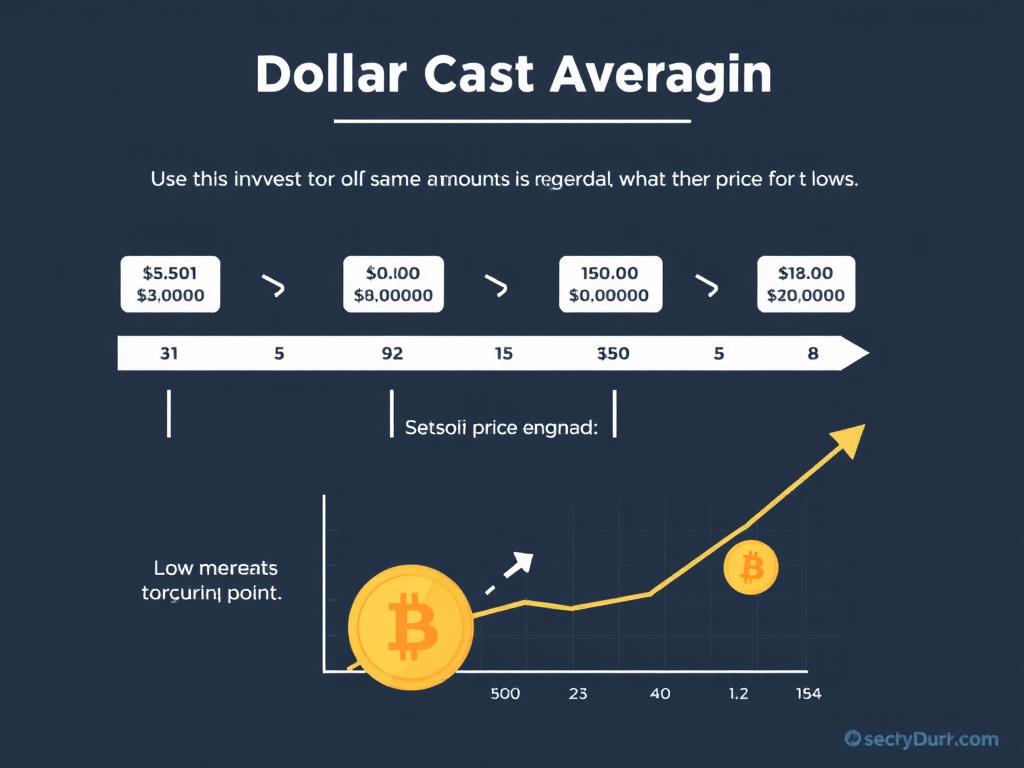
Implementing a DCA strategy in cryptocurrency is straightforward. Here’s a step-by-step breakdown:
- Choose your cryptocurrency: Select which cryptocurrency you want to invest in. For beginners, it’s often recommended to start with established cryptocurrencies like Bitcoin (BTC) or Ethereum (ETH).
- Determine your investment amount: Decide how much money you can comfortably invest on a regular basis. This could be $10, $50, $100, or more, depending on your financial situation.
- Set your investment frequency: Choose how often you’ll invest your fixed amount. Common intervals include weekly, bi-weekly, or monthly.
- Execute consistently: Make your investments according to your schedule, regardless of the cryptocurrency’s current price.
- Hold for the long term: DCA is typically a long-term strategy. Plan to hold your investments for an extended period.
Example: DCA in Action
Let’s look at a practical example of how DCA works with Bitcoin:
| Month | Investment Amount | Bitcoin Price | Bitcoin Purchased | Total Bitcoin Owned |
| January | $100 | $45,000 | 0.00222 | 0.00222 |
| February | $100 | $38,000 | 0.00263 | 0.00485 |
| March | $100 | $42,000 | 0.00238 | 0.00723 |
| April | $100 | $35,000 | 0.00286 | 0.01009 |
| May | $100 | $50,000 | 0.00200 | 0.01209 |
| June | $100 | $40,000 | 0.00250 | 0.01459 |
In this example, you invested a total of $600 and acquired 0.01459 BTC. Your average purchase price would be approximately $41,125 per Bitcoin, even though the price fluctuated between $35,000 and $50,000 during this period.
Benefits of Dollar-Cost Averaging in Cryptocurrency
Advantages of DCA
- Reduces emotional decision-making: By following a predetermined schedule, you avoid making impulsive decisions based on market sentiment or FOMO (fear of missing out).
- Mitigates timing risk: You don’t need to worry about buying at the “wrong time” since you’re spreading your purchases across various price points.
- Lowers average purchase price over time: You automatically buy more when prices are low and less when prices are high, potentially reducing your average cost.
- Creates a disciplined investment habit: Regular investing helps build good financial habits and removes the stress of trying to time the market.
- Simplifies the investment process: Once set up, DCA requires minimal time and effort to maintain.
Limitations of DCA
- May underperform in bull markets: If the market is consistently rising, a lump-sum investment might yield better returns.
- Doesn’t protect against long-term downtrends: If a cryptocurrency’s value declines over an extended period, DCA won’t prevent losses.
- Transaction fees can add up: Multiple small purchases may incur more fees than a single large purchase.
- Requires patience and discipline: You need to stick to your schedule even when the market seems unfavorable.
DCA vs. Lump-Sum Investing in Cryptocurrency
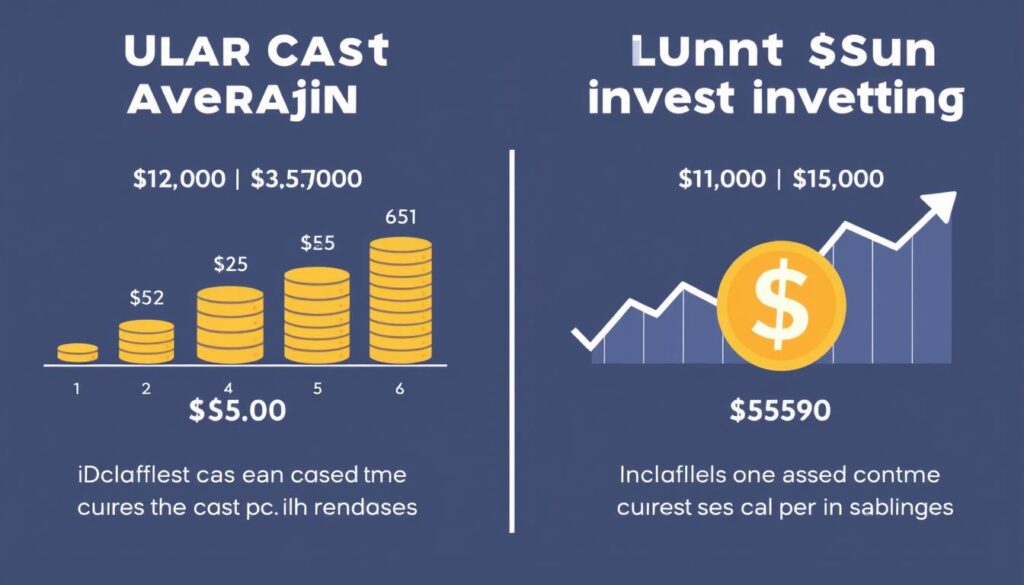
When investing in cryptocurrency, you generally have two main approaches: dollar-cost averaging or lump-sum investing. Each has its advantages and ideal use cases.
| Feature | Dollar-Cost Averaging | Lump-Sum Investing |
| Investment approach | Regular fixed investments over time | One large investment at a single point |
| Risk management | Spreads risk across multiple price points | Concentrated risk at a single price point |
| Emotional impact | Lower stress, systematic approach | Higher stress, requires market timing |
| Best market conditions | Volatile or declining markets | Rising markets |
| Time in market | Partial exposure initially, full exposure over time | Immediate full market exposure |
| Ideal for | Beginners, risk-averse investors | Experienced investors, strong market convictions |
Research has shown that lump-sum investing tends to outperform DCA about two-thirds of the time in traditional markets over the long term. However, cryptocurrency markets are significantly more volatile than traditional markets, which can make DCA a more psychologically comfortable and potentially safer approach for beginners.
Real-Life Scenario: DCA vs. Timing the Market
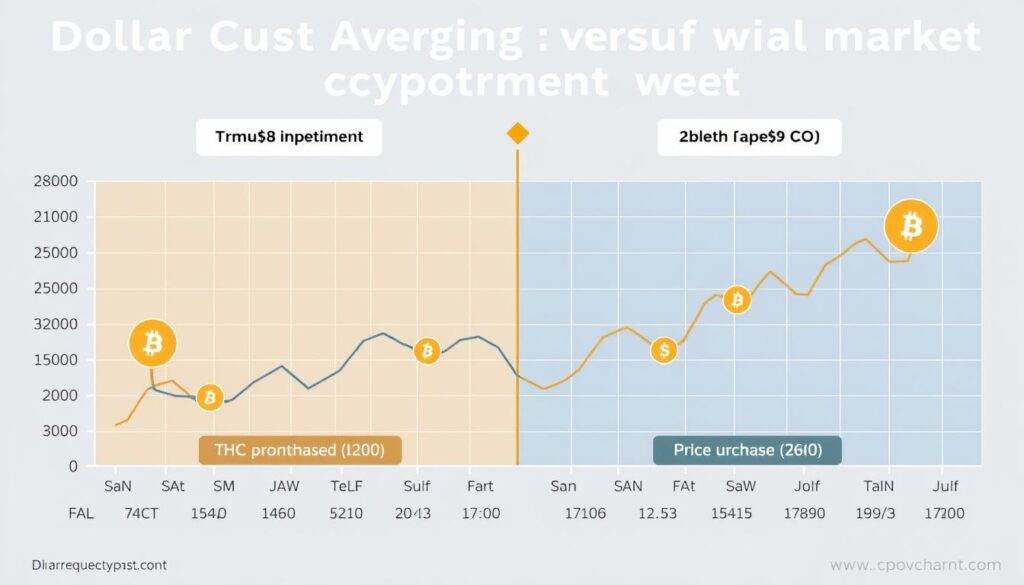
Let’s examine a hypothetical scenario comparing two investors, Alex and Taylor, who each have $6,000 to invest in Bitcoin.
Alex: The Market Timer
Alex tries to time the market, waiting for the “perfect moment” to invest the entire $6,000. After watching Bitcoin’s price for months, Alex finally invests the full amount when Bitcoin is at $42,000, believing it’s about to surge. Unfortunately, Bitcoin drops to $35,000 shortly after, resulting in an immediate paper loss of $1,000.
Taylor: The DCA Investor
Taylor decides to use a DCA strategy, investing $500 in Bitcoin every month for 12 months, regardless of price. Here’s how Taylor’s investment plays out:
| Month | Investment | Bitcoin Price | Bitcoin Purchased | Total Bitcoin | Portfolio Value |
| 1 | $500 | $45,000 | 0.01111 | 0.01111 | $500 |
| 2 | $500 | $42,000 | 0.01190 | 0.02301 | $966 |
| 3 | $500 | $35,000 | 0.01429 | 0.03730 | $1,306 |
| 4 | $500 | $38,000 | 0.01316 | 0.05046 | $1,917 |
| 5 | $500 | $40,000 | 0.01250 | 0.06296 | $2,518 |
| 6 | $500 | $43,000 | 0.01163 | 0.07459 | $3,207 |
After 12 months, Taylor has invested the full $6,000 and accumulated approximately 0.14 BTC. If Bitcoin’s price is $50,000 at the end of this period, Taylor’s investment would be worth $7,000, a 16.7% return.
Meanwhile, Alex’s $6,000 investment at $42,000 would have purchased 0.143 BTC. At $50,000, this would be worth $7,150, a 19.2% return.
In this scenario, Alex’s lump-sum approach yielded slightly better returns. However, this outcome depended entirely on Alex’s entry point. Had Alex invested at $45,000 instead of $42,000, the returns would have been lower than Taylor’s DCA approach.
The key takeaway: While lump-sum investing can potentially yield higher returns, DCA offers more consistent results with less stress and lower risk of poor timing.
Ready to Start Your DCA Journey?
Take the guesswork out of crypto investing with our free DCA calculator. Plan your strategy and see potential results before you invest.
Practical Implementation: Tools for Crypto DCA
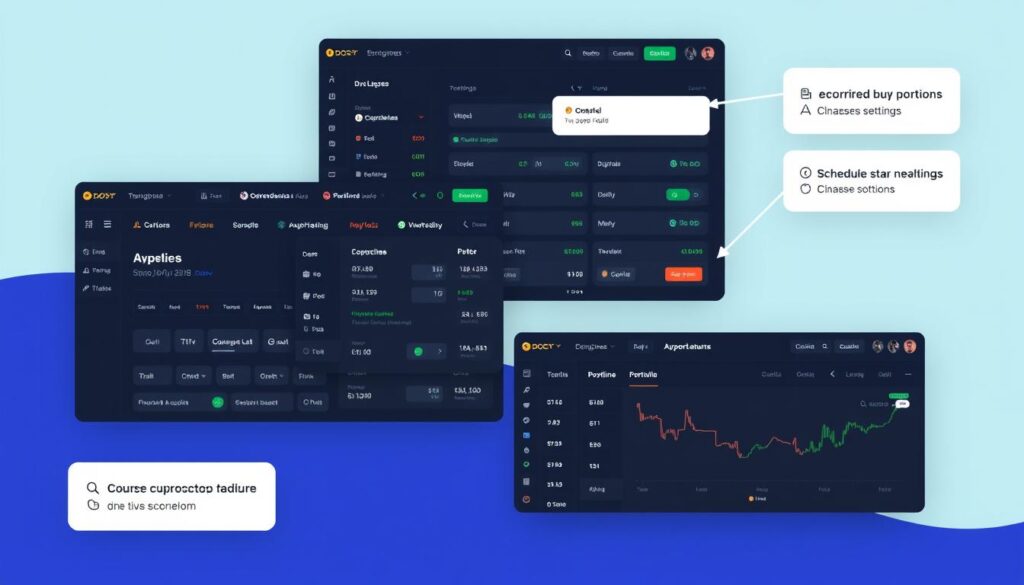
Implementing a DCA strategy for cryptocurrency has become increasingly accessible thanks to various tools and platforms. Here are some options to help you get started:
Cryptocurrency Exchanges with DCA Features
Centralized Exchanges
Many major cryptocurrency exchanges offer recurring buy features that allow you to set up automatic purchases at regular intervals.
- Easy to use for beginners
- Often include portfolio tracking
- May have higher fees
DCA-Specific Platforms
Some platforms are specifically designed for dollar-cost averaging in cryptocurrency, offering specialized features.
- Focused on DCA strategy
- May offer advanced analytics
- Often have competitive fees
Self-Managed Approach
For those who prefer more control, you can manually execute your DCA strategy using calendar reminders.
- Complete control over timing
- Can adjust based on circumstances
- Requires more discipline
Choosing Cryptocurrencies for Your DCA Strategy
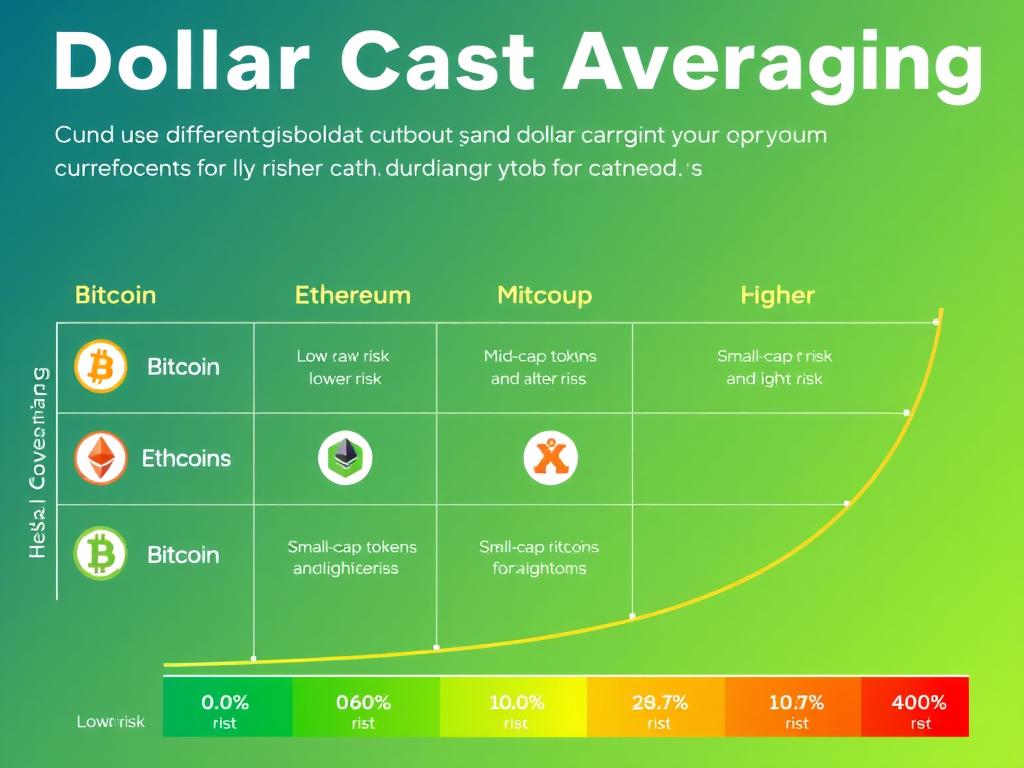
When implementing a DCA strategy, choosing which cryptocurrencies to invest in is crucial. Here are some considerations:
For Conservative Beginners
If you’re new to cryptocurrency and prefer a more conservative approach, consider focusing on established cryptocurrencies:
- Bitcoin (BTC): The original and largest cryptocurrency by market capitalization.
- Ethereum (ETH): The second-largest cryptocurrency, powering a vast ecosystem of decentralized applications.
These cryptocurrencies have longer track records and typically experience less extreme volatility compared to smaller altcoins.
For More Adventurous Investors
If you have more experience or a higher risk tolerance, you might consider allocating a portion of your DCA strategy to:
- Large-cap altcoins: Established alternatives to Bitcoin and Ethereum.
- Mid-cap cryptocurrencies: Projects with solid fundamentals but smaller market caps.
Remember that smaller cryptocurrencies typically come with higher risk and volatility, so they should represent a smaller percentage of your overall portfolio.
Common DCA Mistakes to Avoid
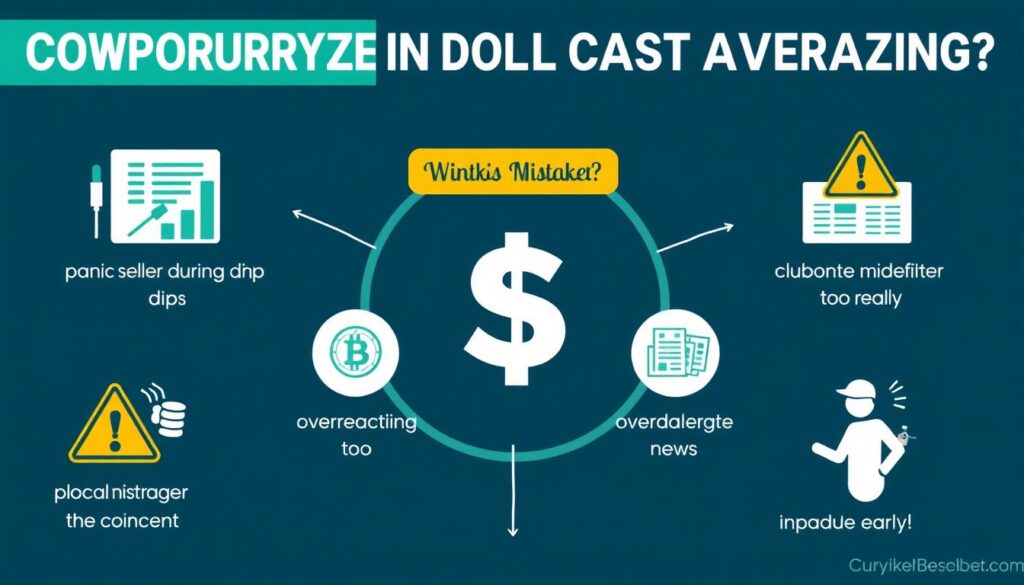
Even with a simple strategy like DCA, there are common pitfalls that can undermine your results. Being aware of these mistakes can help you stay on track.
Emotional Reactions to Market Movements
One of the biggest advantages of DCA is removing emotion from your investment decisions. However, many beginners still fall into these traps:
- Pausing investments during market downturns: Some investors stop their DCA schedule when prices drop, fearing further losses. This defeats the purpose of DCA, which is designed to take advantage of lower prices by acquiring more of the asset.
- Increasing investments during bull runs: Conversely, some investors get excited during price increases and invest more than their scheduled amount. This can lead to buying more at higher prices, which goes against the DCA principle.
Inconsistent Implementation
For DCA to work effectively, consistency is key:
- Irregular investment intervals: Investing sporadically rather than on a fixed schedule undermines the averaging effect of DCA.
- Varying investment amounts: Changing how much you invest each time based on market conditions or personal circumstances can reduce the effectiveness of your DCA strategy.
Short-Term Thinking
DCA is fundamentally a long-term strategy:
- Expecting immediate results: Some beginners abandon their DCA strategy after a few months if they don’t see significant gains. DCA typically shows its benefits over longer periods.
- Frequent portfolio checking: Constantly monitoring your portfolio can lead to anxiety and impulsive decisions. With DCA, it’s better to check less frequently and focus on the long-term trend.
Remember: The power of DCA lies in its simplicity and consistency. Stick to your plan, avoid emotional decisions, and focus on the long-term horizon.
Frequently Asked Questions About Crypto DCA

How often should I invest with a DCA strategy?
The ideal frequency depends on your financial situation and the amount you’re investing. Weekly or monthly intervals are most common. More frequent investments (e.g., weekly) can provide a more granular averaging effect but may incur more transaction fees. Less frequent investments (e.g., monthly) are easier to manage but might miss some averaging opportunities.
Is DCA better than trying to buy the dip?
“Buying the dip” requires you to correctly identify when a cryptocurrency has reached a temporary low point, which is extremely difficult even for experienced traders. DCA removes this guesswork and psychological pressure. While successful dip-buying can potentially yield better returns, DCA offers a more reliable and stress-free approach, especially for beginners.
How long should I continue my DCA strategy?
DCA is typically a long-term strategy, with timeframes ranging from one to several years. The longer you maintain your DCA approach, the more effectively it can smooth out market volatility. Many successful crypto investors continue their DCA strategy indefinitely, adjusting the investment amount as their financial situation changes.
Should I DCA into multiple cryptocurrencies or focus on one?
This depends on your investment goals and risk tolerance. Diversifying your DCA strategy across multiple cryptocurrencies can reduce risk but requires more management. For beginners, starting with a single established cryptocurrency like Bitcoin or Ethereum is often recommended. As you become more comfortable, you can expand your DCA strategy to include additional cryptocurrencies.
What if I have a lump sum to invest right now?
If you have a lump sum available, you might consider a hybrid approach: invest a portion (e.g., 50%) as a lump sum and use the remainder for a DCA strategy. This allows you to gain immediate market exposure while still benefiting from the risk-reduction aspects of DCA.
Conclusion: Starting Your Crypto DCA Journey

Dollar-cost averaging offers a structured, disciplined approach to cryptocurrency investing that’s particularly well-suited for beginners. By investing fixed amounts at regular intervals, you can navigate the volatile crypto markets with less stress and potentially build a substantial portfolio over time.
The key to success with DCA is consistency and patience. Stick to your schedule, avoid emotional reactions to market movements, and maintain a long-term perspective. Remember that DCA isn’t about maximizing short-term gains but rather about building wealth steadily while managing risk.
As you gain experience and confidence, you can refine your DCA strategy by adjusting your investment amount, frequency, or the cryptocurrencies you invest in. The beauty of DCA is its flexibility—it can evolve with your financial situation and investment goals.
Take Your Crypto Investing to the Next Level
Join our community of crypto investors and receive weekly insights, market analysis, and DCA strategies directly in your inbox.

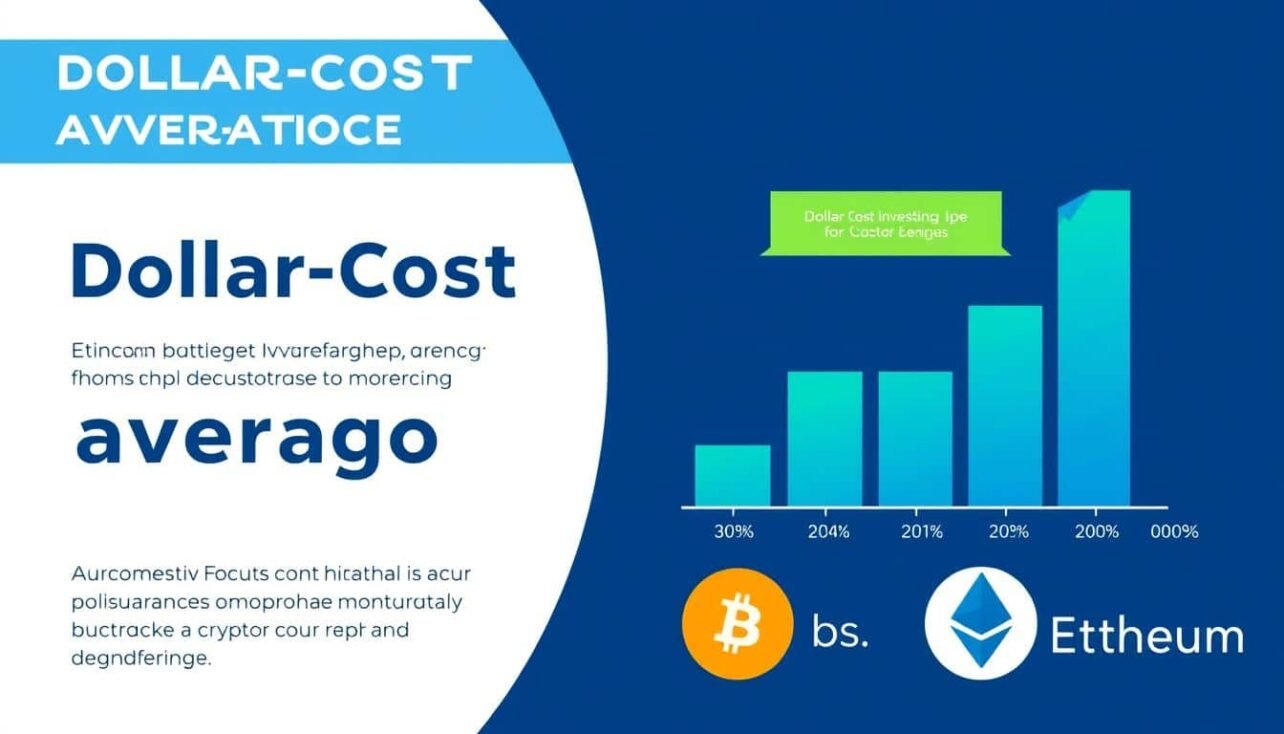
No comments yet